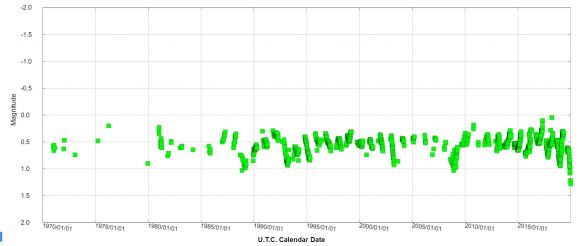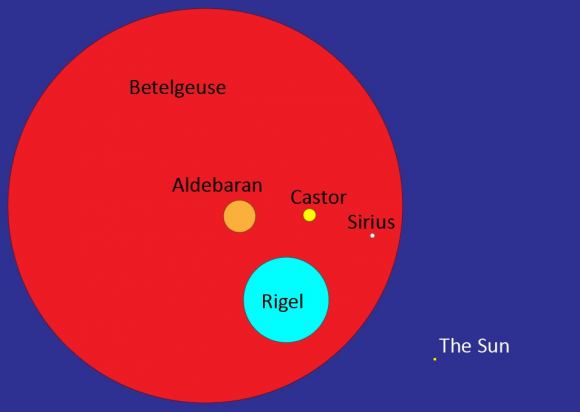Science
Related: About this forumIs Betelgeuse, one of the sky's brightest stars, on the brink of a supernova?
One of the sky’s brightest lights is losing its shine.
Since the start of December, the star Betelgeuse — the gleaming right shoulder of the constellation Orion — has been rapidly growing dim. Just 650 light-years from Earth, it’s usually the ninth most luminous star in the sky. Right now, it wouldn’t even break the top 20.
Betelgeuse is a “variable” star, known for wild fluctuations in its brightness, but scientists have never recorded it changing quite so fast. Such strange behavior from a beloved star has them wondering: Is this a sign that Betelgeuse is about to explode?
Astronomers know that day is bound to come. Betelgeuse is at least 15 times more massive than the sun and wide enough that, if we moved it to our solar system, it would extend past the orbit of Jupiter. “Supergiants” like this tend to live fast and die young, and Betelgeuse’s red color indicates that it has already moved to one of the last stages of a star’s life: fusing helium atoms into ever-heavier elements, which it occasionally spews into space. The carbon in your cells and the oxygen in your lungs was made this way, borne across the universe on the sighs of a dying sun.
https://www.washingtonpost.com/science/2019/12/27/is-betelgeuse-one-skys-brightest-stars-brink-supernova/
progree
(10,909 posts)We started seeing discussion on Betelgeuse trending on social media on the evening of Friday, December 20th, and dug down to the source of the excitement: a December 8th paper on "The Fainting of the Nearby Red Supergiant Betelgeuse" by researchers at Villanova University.
Light curve estimates courtesy of the American Association of Variable Star Observers (AAVSO) verified the assertion that the star had indeed faded about one magnitude, or a little over one half from its usual magnitude +0.5 to +1.5
Noticing the sky was clear, we headed up to our parking garage rooftop observing site in downtown Norfolk, Virginia to take a look. Betelgeuse was indeed noticeably fainter, about a shade dimmer than nearby +1st magnitude Aldebaran.
Magnitude of Betelgeuse, starting in 1970
https://www.universetoday.com/144465/waiting-for-betelgeuse-whats-up-with-the-tempestuous-star/
universetoday.com/wp-content/uploads/2019/12/Mag-est-580x246.jpg

Our (puny) host star, versus the neighbors, including Betelgeuse. Credit: Dave Dick
universetoday.com/wp-content/uploads/2019/12/starss-580x412.jpg

Betelgeuse is the yellow-orange (in this picture) star in the right shoulder of Orion (below)
Rigel is the intensely bluish left foot star
universetoday.com/wp-content/uploads/2019/12/49256912602_2251f44650_c.jpg

at140
(6,110 posts)lapfog_1
(29,213 posts)we will just find out about it now.
at140
(6,110 posts)Knowing how fast light travels, imagine 650 years to reach light source is hard to imagine.
lapfog_1
(29,213 posts)almost next door, as it were
at140
(6,110 posts)how sparsely the universe is populated. Even spacecraft travelling at supersonic speeds, it would require multiple generations of human beings to reach the NEAREST solar system in the Milky Way.
lapfog_1
(29,213 posts)"As of September 2012, sunlight took 16.89 hours to get to Voyager 1 which was at a distance of 121 AU. The apparent magnitude of the Sun from the spacecraft was ?16.3 (less than 30 times the brightness of the full moon).[67] The spacecraft was traveling at 17.043 km/s (10.590 mi/s) relative to the Sun. It would need about 17,565 years at this speed to travel a light-year.[67] To compare, Proxima Centauri, the closest star to the Sun, is about 4.2 light-years (2.65×105 AU) distant. Were the spacecraft traveling in the direction of that star, 73,775 years would pass before Voyager 1 reaches it. (Voyager 1 is heading in the direction of the constellation Ophiuchus.[67])"
It is moving at 10.59 miles/sec (over 36,000 mph). It would take 74,000 years to reach the nearest star. Mankind has only had civilization for 4000 to maybe 5000 years.
Star Travel (Star Trek and so forth) is still a very long ways away for us... and even if we were to build a self sustaining multi-generational ship that could be shielded from interstellar radiation... and could travel much faster than our current generation of space technology... it is unlikely that such a sub light speed trip would ever happen.
All of this is to say... we need to take care of the planet we were born on, moving to another one in the next thousand years is unlikely
at140
(6,110 posts)for the mankind and all other species with life.
eppur_se_muova
(36,271 posts)SCantiGOP
(13,871 posts)I had to read to the end to see that this type of explosion would not send gamma rays toward Earth. Nearby novae can be planet killers.
lapfog_1
(29,213 posts)it will appear again.